The Fed Has Failed (and Will Continue to Fail), Part 1
The Fed's policies have been an unqualified success for financiers and an abject failure for the bottom 99.5% who have to work for a living.
After five long years of politicos and the financial media glorifying the Federal Reserve's policies as god-like in their power and efficacy, let's take a quick look at the results of these vaunted policies: ZIRP (zero interest rates), (QE) quantitative easing, both of which are ways of shoving nearly limitless, nearly-free money ( a.k.a. liquidity) into the banking sector, where all this free money is supposed to filter into the global economy, working miracles of prosperity.
Let's start with a chart of the Fed's balance sheet, which reflects just how much money the Fed has created and pumped into the financial system. $4 trillion is larger than the entire GDP of Germany, and roughly 25% of U.S. GDP.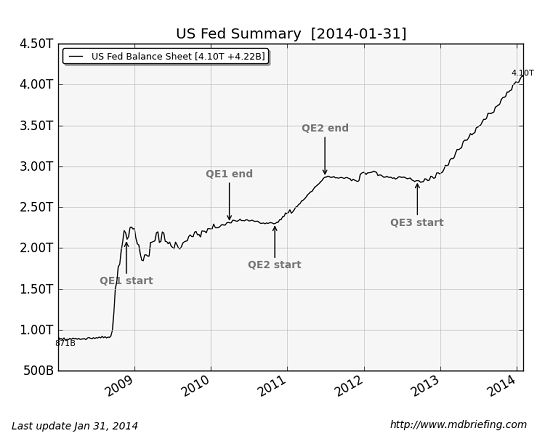
Next, let's look at the effect of the much-glorified Fed policies on full-time employment: If you call a return to the levels of 2005 (despite a 7.5% increase in population) a success, then what would you consider a failure?
Let's recall that the Fed's policies are unprecedented. Keeping interest rates near-zero for five years and pumping $4 trillion into the system are both completely off the scale of central bank policy in the U.S.
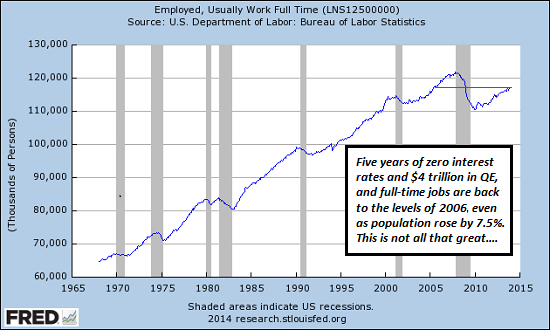
Next, let's look at the participation rate--how many people of working age who are actively in the workforce. The trend is ugly; the percentage of the civilian population who are working or actively seeking work is plummeting.
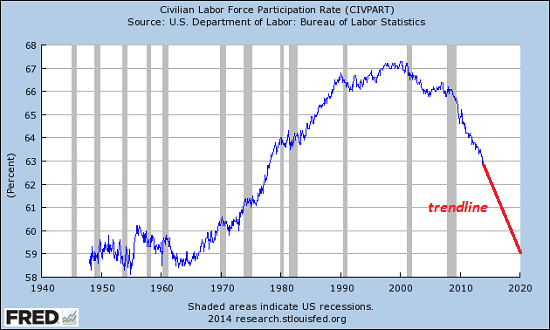
Next: real median household income: this is household income adjusted for inflation.Another ugly chart, as real median household income is back to the levels of 1990. Once again: if you reckon this a success, then what would you consider a failure?
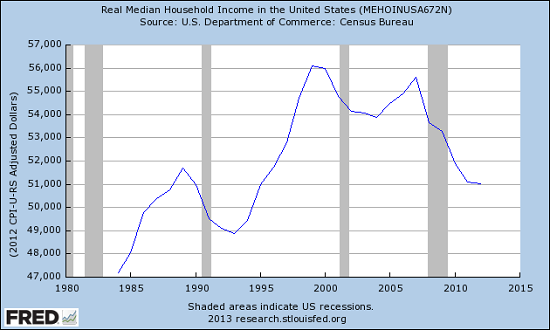
How about the annual change in disposable income? we can assume that "prosperity" and "recovery" mean disposable income are rising at a healthy clip, right? Alas, the rate of disposable income growth is sinking toward zero. The Fed's policies of bailing out "too big to fail" banks and QE/ZIRP have correlated to the most stunning drop in disposable income growth in decades.
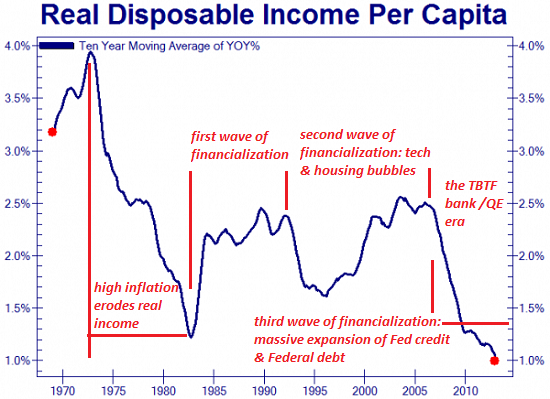
How about financial sector profits? Hey, now we're finally getting somewhere-- these are through the roof. We finally found something with a positive correlation to Fed policies--financial profits are hitting all-time highs. Yee-haw, we have a winner.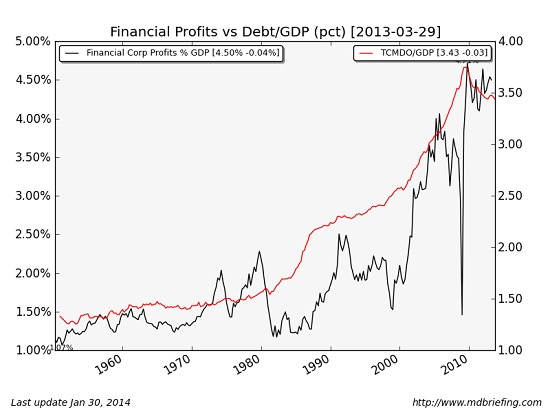
Last but not least, how about the stock market? Here is a chart of the Fed balance sheet and the S&P 500 since 2009. Ding-ding, we have another winner--stocks are also hitting all-time highs.
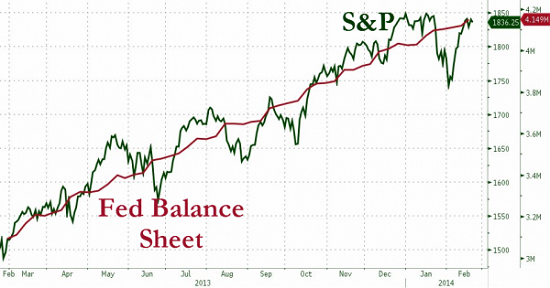
Source: Zero Hedge
The most charitable assessment we can make of Fed policy is that the "prosperity" it created is at best, ahem, grossly concentrated in the most parasitic and politically powerful sector: finance. Why should we be surprised that the Fed, itself a servant of the banking sector, should devise policies that enrich the bankers and financiers?
Let's be clear about one thing (to quote the president): the Fed's policies have been an unqualified success for financiers and an abject failure for everyone who has to work for a living. The Fed has not just failed to rectify the nation's obscene inequality in wealth and income; it has actively widened it by handing guaranteed returns to the banks and financiers while stripmining what's left of the middle and working classes' non-labor income, i.e. interest on savings.
Just as a refresher:
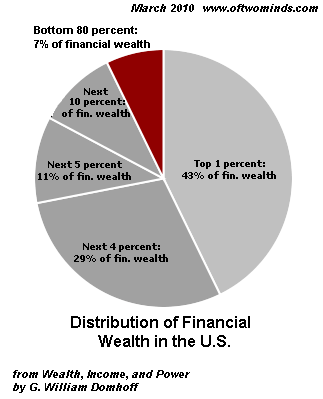
Tomorrow: how the Fed rewards imprudent parasites and punishes the prudently productive.
The Nearly Free University and The Emerging Economy:
The Revolution in Higher Education
Reconnecting higher education, livelihoods and the economyWith the soaring cost of higher education, has the value a college degree been turned upside down? College tuition and fees are up 1000% since 1980. Half of all recent college graduates are jobless or underemployed, revealing a deep disconnect between higher education and the job market.
It is no surprise everyone is asking: Where is the return on investment? Is the assumption that higher education returns greater prosperity no longer true? And if this is the case, how does this impact you, your children and grandchildren?

We must thoroughly understand the twin revolutions now fundamentally changing our world: The true cost of higher education and an economy that seems to re-shape itself minute to minute.
The Nearly Free University and the Emerging Economy clearly describes the underlying dynamics at work - and, more importantly, lays out a new low-cost model for higher education: how digital technology is enabling a revolution in higher education that dramatically lowers costs while expanding the opportunities for students of all ages.
The Nearly Free University and the Emerging Economy provides clarity and optimism in a period of the greatest change our educational systems and society have seen, and offers everyone the tools needed to prosper in the Emerging Economy.
Read Chapter 1/Table of Contents
print ($20) Kindle ($9.95)
Things are falling apart--that is obvious. But why are they falling apart? The reasons are complex and global. Our economy and society have structural problems that cannot be solved by adding debt to debt. We are becoming poorer, not just from financial over-reach, but from fundamental forces that are not easy to identify. We will cover the five core reasons why things are falling apart:
 1. Debt and financialization
1. Debt and financialization2. Crony capitalism
3. Diminishing returns
4. Centralization
5. Technological, financial and demographic changes in our economy
Complex systems weakened by diminishing returns collapse under their own weight and are replaced by systems that are simpler, faster and affordable. If we cling to the old ways, our system will disintegrate. If we want sustainable prosperity rather than collapse, we must embrace a new model that is Decentralized, Adaptive, Transparent and Accountable (DATA).
We are not powerless. Once we accept responsibility, we become powerful.
Read the Introduction/Table of ContentsKindle: $9.95 print: $24
| Thank you, Craig H. ($50), for your wondrously generous contribution to this site -- I am greatly honored by your steadfast support and readership. | Thank you, Gunnar A. ($50), for your stupendously generous contribution to this site -- I am greatly honored by your steadfast support and readership. |



























